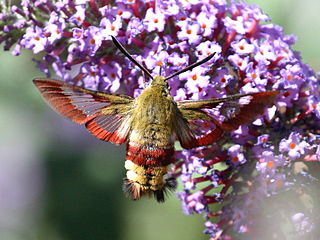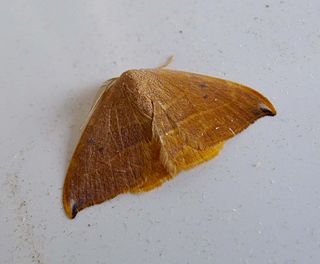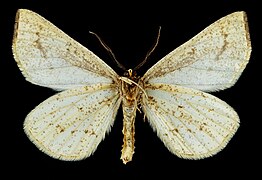
Melanargia galathea, the marbled white, is a medium-sized butterfly in the family Nymphalidae. Despite its common name and appearance, this butterfly is one of the "browns", of the subfamily Satyrinae.

Sphinx chersis, the great ash sphinx or northern ash sphinx, is a moth that belongs to the family Sphingidae.

Lintneria eremitus, the hermit sphinx, is a moth of the family Sphingidae. The species was first described by Jacob Hübner in 1823. It is found in the temperate areas of the eastern United States, north into southern Canada over the Great Plains. It prefers gardens and yards, but is common wherever the nectar and larval host plants are found. This moth is easily confused with the Canadian sphinx but these two moths do not typically co-occur.

The orange swift or orange moth is a moth belonging to the family Hepialidae. The species was first described by Carl Linnaeus in 1761 and was previously placed in the genus Hepialus. It is distributed throughout Europe.

Aellopos ceculus is a moth of the family Sphingidae.

Hemaris tityus, the narrow-bordered bee hawk-moth, is a moth of the family Sphingidae which is native to the Palearctic.

The willowherb hawkmoth is a moth in the family Sphingidae. The species was first described by Peter Simon Pallas in 1772.

Zygaena trifolii, the five-spot burnet, is a day-flying moth in the family Zygaenidae found in North Africa and Europe. It was described by the German zoologist Eugenius Johann Christoph Esper in 1783 from the type specimen found in Frankfurt am Main, Germany.

Drepana falcataria, the pebble hook-tip, is a moth of the family Drepanidae. The species was first described by Carl Linnaeus in his 1758 10th edition of Systema Naturae. It is found in Europe, through Siberia to the eastern Palearctic.

Falcaria lacertinaria, the scalloped hook-tip, is a moth of the family Drepanidae. The species was first described by Carl Linnaeus in his 1758 10th edition of Systema Naturae It is found in Europe and Anatolia then east to Eastern Siberia.

Hemaris fuciformis, known as the broad-bordered bee hawk-moth, is a moth of the family Sphingidae.

Chamaesphecia empiformis is a moth of the family Sesiidae.

Carterocephalus silvicola, the northern chequered skipper, is a species of butterfly of the family Hesperiidae. It is found in northern Europe and the northern and eastern Palearctic.

Boloria napaea, the Napaea fritillary or mountain fritillary, is a butterfly of the family Nymphalidae.

Deilephila askoldensis is a moth of the family Sphingidae.

Angonyx testacea, the northern dark-green hawkmoth, is a moth of the family Sphingidae.

Problepsis ocellata is a moth of the family Geometridae.

Drepana uncinula, the spiny hook-tip, is a moth in the family Drepanidae.

Melanargia larissa, the Balkan marbled white, is a butterfly in the family Nymphalidae. It is found from south-eastern Europe and Asia Minor to Transcaucasia and north-western Iran. The habitat consists of dry grasslands, scrubby hillsides and grassy woodland glades. Adults are on wing from mid-May to July in one generation per year.























